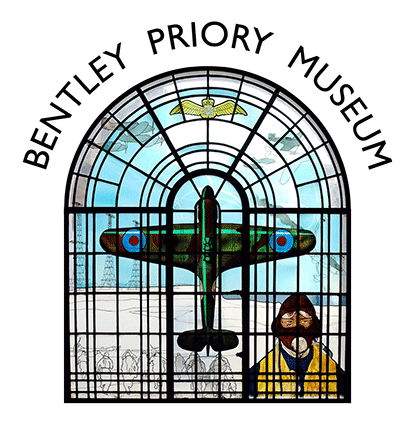Maureen Hokay, 1992
Dimensions: 300cm x 50cm
Material: Glass
To listen to the audio description of this object either click the object audio MP3 file below which will play it in your default audio player, or press the play button which you will find after the object audio MP3 file and this will play it from within the web page. The play button can also be used to pause the audio. This button is followed by the elapsed and remaining time, and a further button to mute the audio.
Royal Observer Corps Window Audio MP3 File
The Royal Observer Corps commemorative stained glass window is positioned in the Entrance Hall at Bentley Priory Museum.
The Observer Corps were integral during the Battle of Britain, identifying and reporting incoming enemy aircraft as they flew over the skies of Britain. They became known as the ‘eyes and ears’ of the Royal Air Force, identifying aircraft by sight and by sound.
The window is a rectangle, portrait in orientation, with a curved top. It is narrow, about half a meter wide and almost three meters high at the tallest point. The black leading of the stained glass window panes follow the shape of the window, forming arches where the window curves at the top.
In the background, white aircraft condensation trails cross the bright blue sky. In the foreground, at the bottom of the window, is a black and white Royal Observer Corps post instrument – a mechanical sighting device, with a flat circular base and a long narrow telescope pointing up in the sky. There is a man in a metal helmet working the device, his right hand tweaking the height of the telescope. In the background, about half way up the window, is the skyline of London, which includes the dome of St Paul’s Cathedral. To the right of St Paul’s, is a man in Royal Observer Corps uniform, portrayed in profile holding binoculars to his eyes and looking up into the sky.
At the top of the window in the curve of the arch is the Royal Observer Corps badge, depicted in a yellow gold. It is a circular wreath of laurel with a sixteenth century soldier wearing a breastplate and helmet in the centre, standing on green grass. His right arm is holding a flaming torch above his head, while his left hand shields his eyes from the elements to look out into the distance. There is a crown mounted on the top of the wreath and the motto ‘Forewarned is forearmed’ sits in a scroll below.
In the lower part of the window is a scroll with the text ‘Royal Observer Corps’.
The Royal Observer Corps was based at RAF Bentley Priory from July 1936. Originally known as the Observer Corp, they were awarded Royal status in 1941 in recognition of their crucial role during the Battle of Britain. Their information about incoming enemy raids over land supported the information coming from the radar stations, which only gave warnings of enemy raids approaching Britain’s coastline. The Observer Corps used aircraft recognition books and cards, which contained silhouettes of enemy and friendly aircraft to support their identification.
 What’s On
What’s On Opening Hours & Admission
Opening Hours & Admission
